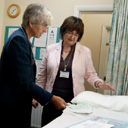
From the patients' point of view, not much has changed at Cuckoo Lane surgery, in Hanwell, west London, since it transformed into a nurse-led social enterprise after three former employees decided to run the practice themselves.
Where once GPs ran the show, nurses are now in charge; where bottom-line profits used to determine the size of the doctors' salaries, now they are ploughed back into service innovation. Patients are offered appointments with the most appropriate practitioner, to free doctors to see the more complex cases.
Carol Sears, Anne Hamerton and Nicci Boyce, who work respectively as clinical lead, practice nurse and manager, decided to take the reins after both doctors at the two-handed practice retired at the same time. "We didn't fancy being employed by a new team of doctors when I was already a profit-share partner in the doctors' business," says Sears, who qualified as a nurse practitioner nine years ago.
The traditional management model for a GP surgery is that doctors buy the buildings and pay staff a salary, while their own salaries come out of any profits. Sears and her colleagues were struck by the limitations that a small business creates when trying to develop new ways of working. "If you do, you know you are taking from partners' profits. It doesn't encourage innovation," says Sears.
The team turned to a not-for-profit group, ECT, run by Sears' husband. It promotes social enterprise, and sketched out a nurse-led practice model in its successful bid for the list of just over 4,000 patients. Nurse practitioners and practice nurses can deal with 70% of the complaints that come through the doors each day, according to Sears, from coughs, colds and rashes to the management of long-term conditions such as diabetes. With this in mind, they wanted to reduce the number of doctors from two full-time to the equivalent of 1.5. But the Ealing primary care trust had reservations about patients' willingness to accept fewer doctors and more nurses. "It felt it would be too big a change bringing in another nurse practitioner, so as a condition of contract we had to have the same number of GPs as before for the first three months," says Sears. "We are now able to employ another nurse practitioner."
ECT has helped the three women with the business side of things by picking up the "higher management stuff", such as accountancy, sorting out insurance and employment contracts.
Janet Baldock retired as a doctor from the practice two years ago but returned as a locum last April. Not only is she free of the burdens that running a business once brought but she no longer has to spend her time seeing patients who call to discuss the mildest of complaints. "I see patients who really need to see the doctor more often," she says. "My training is appropriately valued as I am getting complicated patients and [I am] given more time to deal with them."
Sears admits that now, six months into its new existence, the surgery finances are "tight". Once that changes, and profits are made, ECT will receive a profit percentage share, of between 3% and 5%.
The surgery has just started conducting a survey of 100 patients to gauge their response to the new service. "We have had 20 questionnaires back so far, with some very positive, quite nice comments," says Sears.

